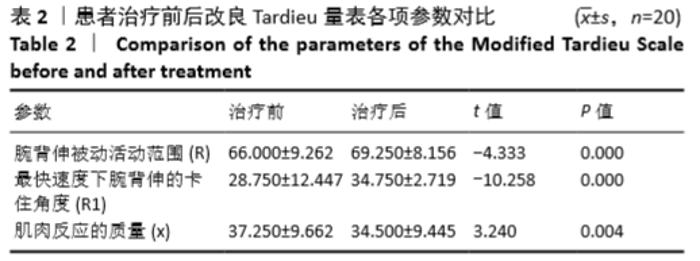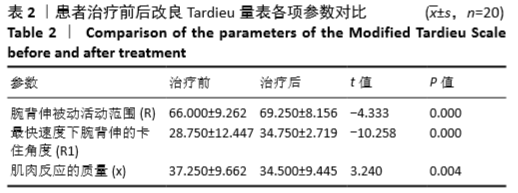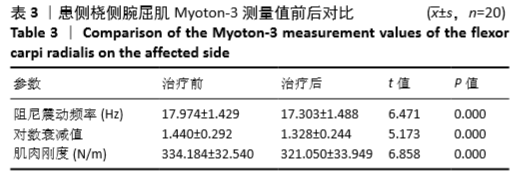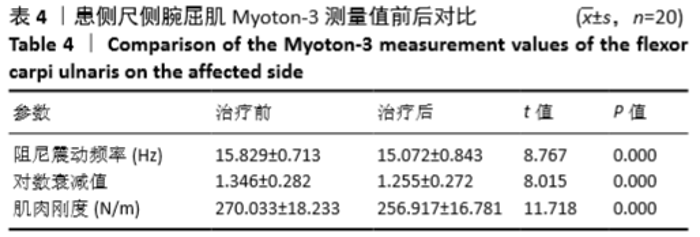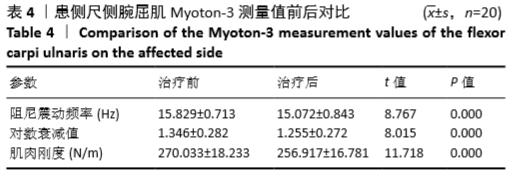[1] ENGLISH C, MCLENNAN H, THOIRS K, et al. Loss of skeletal muscle mass after stroke: a systematic review. Int J Stroke. 2010;5(5):395-402.
[2] 徐思维,缪芸,郁嫣嫣,等.体外冲击波疗法用于缓解痉挛的研究进展[J].中国康复医学杂志,2015,30(5):522-524.
[3] GUO P, GAO F, ZHAO T, et al. Positive effects of extracorporeal shock wave therapy on spasticity in poststroke patients: a meta-analysis.J Stroke Cerebrovasc Dis. 2017; 26(11):2470-2476.
[4] REKAND T. Clinical assessment and management of spasticity: a review. Acta Neurol Scand 2010;122:62-66.
[5] FLEUREN JFM, VOERMAN GE, ERREN-WOLTERS CV, et al. Stop using the Ashworth Scale for the assessment of spasticity. J Neurol Neurosurg Psychiatry. 2010;81(1):46-52.
[6] LI S, FRANCISCO GE. New insights into the pathophysiology of post-stroke spasticity.Front Hum Neurosci. 2015;9:192.
[7] LI S, SHIN H, ZHOU P, et al. Different effects of cold stimulation on reflex and non-reflex components of Poststroke spastic hypertonia.Front Neurol. 2017;8:169.
[8] AIRD L, SAMUEL D, STOKES M. Quadriceps muscle tone, elasticity and stiffness in older males: reliability and symmetry using the MyotonPRO.Arch Gerontol Geriatr. 2012;55(2): e31-e39.
[9] MARUSIAK J, JASKÓLSKA A, BUDREWICZ S, et al. Increased muscle belly and tendon stiffness in patients with Parkinson’s disease, as measured by myotonometry.Mov Disord. 2011;26(11):2119-2122.
[10] LO WLA, ZHAO JL, LI L, et al.Relative and Absolute Interrater Reliabilities of a Hand-Held Myotonometer to Quantify Mechanical Muscle Properties in Patients with Acute Stroke in an Inpatient Ward.Biomed Res Int. 2017; 2017:4294028.
[11] MORRIS S. Ashworth and Tardieu Scales: Their clinical relevance for measuring spasticity in adult and paediatric neurological populations.Physical Therapy Reviews.2002; 7(1):53-62.
[12] 林歆,丛芳,吴琼,等.体外冲击波对偏瘫患者上肢痉挛的疗效观察[J].中国康复理论与实践,2013,19(8):755-758.
[13] CHUANG L, WU C, LIN K. Reliability, validity, and responsiveness of myotonometric measurement of muscle tone, elasticity, and stiffness in patients with stroke.Arch Phys Med Rehabil. 2012;93(3):532-540.
[14] AARRESTAD DD, WILLIAMS MD, FEHRER SC, et al. Intra-and interrater reliabilities of the myotonometer when assessing the spastic condition of children with cerebral palsy. J Child Neurol. 2004;19(11):894-901.
[15] 郭佳宝,朱毅,陈炳霖,等.放散式体外冲击波治疗脑卒中后肢体痉挛的系统评价[J].中国康复医学杂志,2017,32(2):207-212.
[16] MANGANOTTI P, AMELIO E. Long-term effect of shock wave therapy on upper limb hypertonia in patients affected by stroke. Stroke. 2005;36(9): 1967-1971.
[17] DALIRI SS, FOROGH B, EMAMI RAZAVI SZ, et al. A single blind, clinical trial to investigate the effects of a single session extracorporeal shock wave therapy on wrist flexor spasticity after stroke. NeuroRehabilitation. 2015;36(1): 67-72.
[18] CHUANG LL, LIN KC, WU CY, et al. Relative and absolute reliabilities of the myotonometric measurements of hemiparetic arms in patients with stroke.Arch Phys Med Rehabil. 2013;94(3):459-466.
[19] MARUSIAK J, KISIEL-SAJEWICZ K, JASKÓLSKA A, et al. Higher muscle passive stiffness in Parkinson’s disease patients than in controls measured by myotonometry.Arch Phys Med Rehabil. 2010;91(5):800-802.
[20] CHUANG L, WU C, LIN K, et al. Quantitative mechanical properties of the relaxed biceps and triceps brachii muscles in patients with subacute stroke: a reliability study of the myoton-3 myometer.Stroke Res Treat. 2012;2012:617694.
[21] WANG JS, LEE SB, MOON SH.The immediate effect of PNF pattern on muscle tone and muscle stiffness in chronic stroke patient.J Phys Ther Sci. 2016;28(3):967-970.
[22] 李亚鹏,冯亚男,朱毅,等.基于新型肌肉定量评估仪分析影响小腿三头肌硬度的因素[J].中国康复理论与实践,2018,24(4): 442-446.
[23] AGYAPONG-BADU S, WARNER M, SAMUEL D, et al. Measurement of ageing effects on muscle tone and mechanical properties of rectus femoris and biceps brachii in healthy males and females using a novel hand-held myometric device.Arch Gerontol Geriatr. 2016;62:59-67.
[24] YANG TH, HUANG YC, LAU YC, et al. Efficacy of radial extracorporeal shock wave therapy on lateral epicondylosis, and changes in the common extensor tendon stiffness with pretherapy and posttherapy in real-time sonoelastography: a randomized controlled study.Am J Phys Med Rehabil. 2017; 96(2):93-100.
[25] YAMAYA S, OZAWA H, KANNO H, et al. Low-energy extracorporeal shock wave therapy promotes vascular endothelial growth factor expression and improves locomotor recovery after spinal cord injury.J Neurosurg. 2014;121(6): 1514-1525.
[26] MARIOTTO S, CAVALIERI E, AMELIO E, et al. Extracorporeal shock waves: from lithotripsy to anti-inflammatory action by NO production.Nitric Oxide. 2005;12(2):89-96.
[27] BIZZINI M, MANNION AF. Reliability of a new, hand-held device for assessing skeletal muscle stiffness. Clin Biomech (Bristol, Avon). 2003;18(5):459-461.
|
